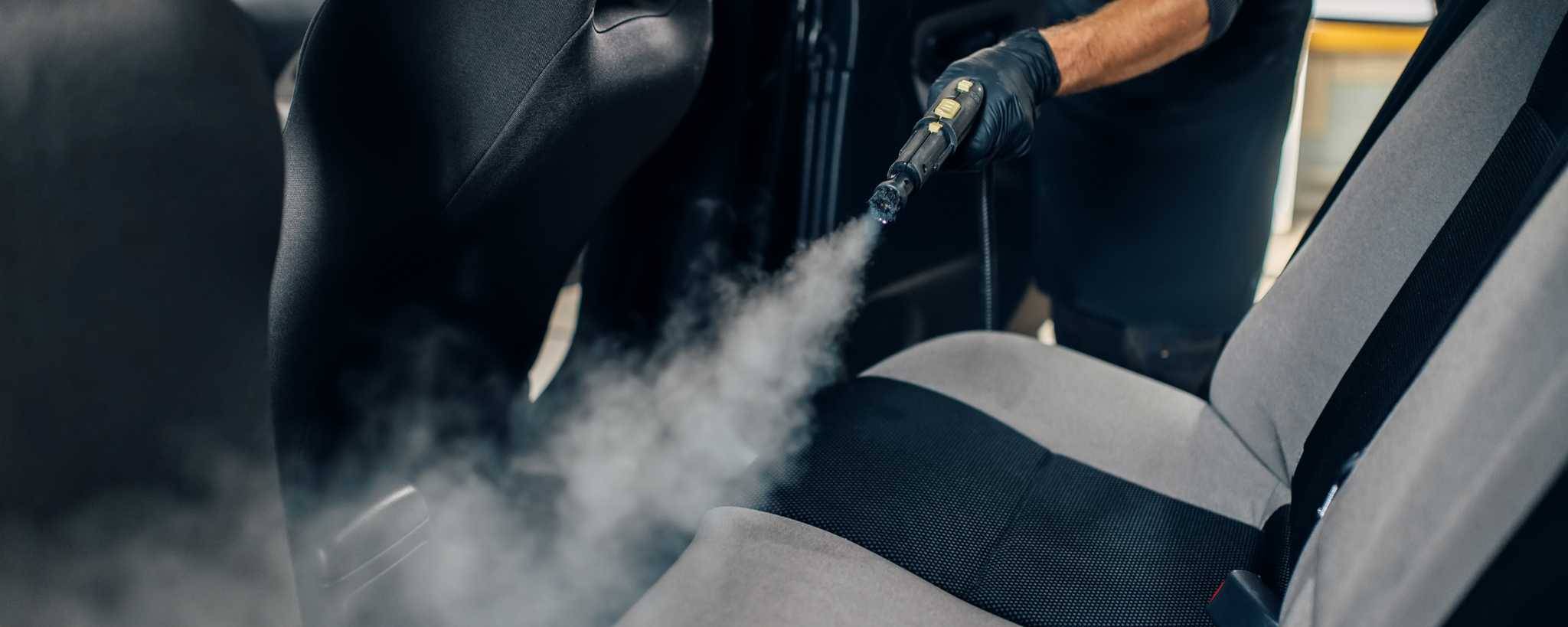Complete Car Detailing With a Steam Cleaner
Achieve a fresh, stain-free interior effortlessly! Clean car seats with a steamer for powerful stain removal and deep sanitization like the pros!

Written by:
Parham Koukia
Reviewed By:
Editorial Team
Published: February 03, 2025
Updated: September 26, 2025
Use AI to summarize this article:
Steam cleaning is one of the most effective ways to keep your car clean by removing dirt, bacteria, and unpleasant odors without using harsh chemicals. Unlike traditional surface cleaning, it reaches tight spaces, sanitizes surfaces, and lifts grime from upholstery with minimal effort.
This guide covers the step-by-step process of steam cleaning a car along with the benefits of using a steam cleaner.
How to Detail a Car With a Steam Cleaner
Gather Your Equipment
Before you begin, make sure you have everything needed to steam clean your car properly:
- A reliable steam cleaner (handheld or full-sized, depending on your needs).
- Clean microfiber cloths for drying and wiping surfaces.
- Soft-bristle brushes for stubborn dirt on leather or plastic trims.
- Vacuum cleaner to remove loose debris before steaming.
- Extension cord if your steam cleaner has a short cable.
Prepare Car Interior
- Remove all loose items, including trash, personal belongings, and floor mats.
- Vacuum seats, carpets, and crevices to eliminate dust, crumbs, and pet hair.
- Check upholstery for stains that may require extra attention during steaming.
Setup the Steam Cleaner
- Fill the steam cleaner with deionized water to prevent mineral buildup.
- Select the appropriate nozzle attachment based on the surface you’re cleaning.
- Allow the device to heat up until it reaches optimal steam pressure (varies by model).
Steam Clean the Upholstery and Carpets
- Attach a fabric-safe nozzle and start with one seat at a time.
- Press the steam trigger lightly while moving the nozzle in circular motions to lift dirt.
- Use a dry microfiber cloth to absorb moisture immediately to prevent damp spots.
- If your cleaner has a crevice tool, target tight areas like seat seams and carpet edges.
Clean Leather and Hard Surfaces
- Switch to a soft-bristle brush attachment to prevent scratching leather and plastic.
- Work gently across the dashboard, center console, door panels, and vents.
- If cleaning leather seats, wrap a microfiber cloth around the nozzle to avoid over-moisturizing.
Detail Small Crevices
- Use a precision nozzle for buttons, cup holders, gear shifts, and air vents.
- Blast short bursts of steam to loosen dirt and sanitize surfaces.
- Wipe excess moisture to keep electronics safe from overheating.
Clean The Windows
- Attach a window squeegee tool or use a steam lance with a microfiber cloth.
- Steam small sections at a time and wipe immediately for a streak-free shine.
Finish with Floor Mats and Final Touches
- If you have rubber mats, steam clean them separately and let them dry before reinstalling.
- Open all doors for ventilation, allowing moisture to evaporate naturally.
- Apply a leather conditioner (if applicable) to maintain the material’s softness.
Benefits of Using a Steam Cleaner for Car Cleaning
1. Chemical-Free Cleaning Process
Steam cleaning only requires water, eliminating the need for harsh chemicals that can damage surfaces or leave behind residues.
2. Deep Cleaning and Sanitization
The high-temperature steam kills bacteria, allergens, and mold spores while removing deeply embedded dirt from carpets, seats, and vents.
3. Safe for Multiple Surfaces
Steam cleaners can be used on:
- Fabric & leather seats
- Carpets & floor mats
- Dashboards & touchscreens
- Air vents & cup holders
- Glass windows (streak-free cleaning)
4. Eliminates Odors at the Source
Steam doesn’t just mask odors, it neutralizes smoke, pet, and food smells by breaking down odor-causing bacteria.
5. Reach Hard-to-Clean Areas
Attachments allow steam to penetrate into crevices, buttons, and tight spaces that are difficult to clean with traditional methods.
Traditional Cleaning Vs. Steam Cleaning
While traditional cleaning relies on chemical-based products, scrubbing, and manual labor to remove dirt and stains, steam cleaning uses high-temperature steam to break down grime, bacteria, and odors without harsh chemicals.
Traditional cleaning often requires multiple cleaners for different surfaces and can leave behind residues, whereas steam cleaning is a one-step process that deep cleans and sanitizes at the same time.
Additionally, traditional methods struggle to reach tight areas like cup holders, air vents, and seat crevices, while steam cleaning effectively penetrates these spaces for a more thorough clean. However, steam cleaning requires careful moisture control to avoid over-wetting sensitive surfaces like electronics and headliners.
While traditional cleaning may be suitable for quick touch-ups, steam cleaning provides a deeper, chemical-free clean with longer-lasting results.
Recommended Steam Cleaners for Car Detailing
Best Budget Option: The BISSELL Steam Shot Omni Handheld Steam Cleaner
- Affordable and easy to use.
- Compact design, ideal for cleaning tight car spaces.
- Heats up in 30 seconds.
- Produces enough steam to tackle dirt, grease, and stains.
- Comes with multiple attachments for spot treatments and chemical-free cleaning.
- Great for light detailing, not suitable for big jobs or tough stains.
- Price: ~$50 CAD.
Best for Heavy-Duty Cleaning: Dupray HILL INJECTION Steam Cleaner
- High-performance steam cleaner with powerful steam pressure.
- Features continuous refill capability for uninterrupted cleaning.
- Heats up quickly and delivers deep cleaning for tough stains, grease, and bacteria.
- Adjustable steam levels and multiple attachments for various surfaces.
- Dual-tank system allows longer cleaning sessions.
- Ideal for professionals and heavy-duty jobs.
- Price: ~$2500 CAD.
Most Versatile Option: Dupray Neat Steam Cleaner
- Compact yet powerful, suitable for both car detailing and household use.
- Heats up quickly and maintains consistent steam pressure.
- Includes multiple attachments and a large water tank for versatile cleaning.
- The lightweight design makes it easy to maneuver.
- Great for quick and effective cleaning of multiple surfaces.
- Price: ~$200 CAD.
Best for Quick Jobs: McCulloch MC1375 Canister Steam Cleaner
- Heats up in under 10 minutes.
- Offers strong steam pressure and a large water tank.
- Great for deep cleaning car interiors and household surfaces.
- Comes with multiple attachments for different cleaning tasks.
- Long power cord and hose provide extra flexibility.
- Powerful steam output ensures effective cleaning of stubborn dirt and grime.
- Price: ~$370 CAD.
Frequently Asked Questions
Is Steam Cleaning Good For Cars?
Yes, steam cleaning is one of the most effective and safest methods for detailing a car. Unlike traditional cleaning methods that rely on chemicals, steam cleaning uses high-temperature vapor to remove dirt, bacteria, and allergens without damaging surfaces.
Are There Any Disadvantages of Steam Cleaning a Car?
While steam cleaning is highly effective, excessive moisture on sensitive areas like electronics, leather, or headliners can cause damage if not used correctly. It also requires proper ventilation after cleaning to prevent dampness. The initial cost of a quality steam cleaner may be higher than traditional tools, and beginners may need practice to use it efficiently. However, when done correctly, steam cleaning provides a deep, chemical-free clean with long-term benefits.
Is Steam Cleaning Safe for Leather Seats?
Yes. Steam clean a leather car seat with a low-heat setting and keep the steam at a distance to avoid drying or damaging the leather.
After steam cleaning, applying a leather conditioner is recommended by car detailing professionals to maintain moisture and prevent cracks.

Parham Koukia
Lead Car Detailer / Operations Manager
With nearly 15 years of hands-on detailing experience, Parham has become a trusted authority in the auto care world. His work is regularly spotlighted in leading outlets like CNN, GoBankingRates, and Family Handyman. Parham likes to share his knowledge to offer in-depth tips on equipment selections, seasonal car care, and some secret car cleaning tips used by detailers in the real world!
Read more
